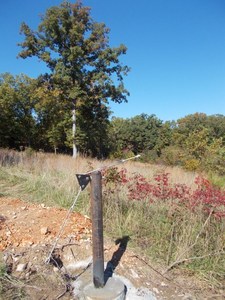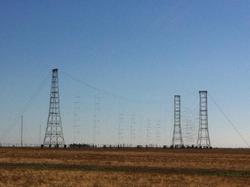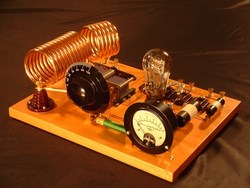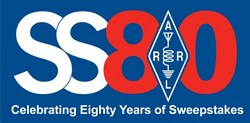 October 23, 2013 Editor: Ward Silver, NØAX | ||||||||
IN THIS ISSUE
NEW HF OPERATORS - THINGS TO DO How about joining in the fun this weekend to fill your log with DX from hither and yon? The CQ World Wide Contest's everybody-works-everybody format means absolutely cram-jammed bands, but it's worth elbowing your way into the pileups to log some DX. (Note that you get no QSO points for working stations in your own country - only zone and country multipliers - so focus on the DX stations.) If you consider Morse more mellifluous, measure your mettle in the following weekend's ARRL Sweepstakes' CW contest. BULLETINS There are no bulletins in this issue. BUSTED QSOS Nothing required emending in the previous issue. CONTEST SUMMARY Complete information for all contests follows the Conversation section October 26-27
November 2-3
Who will be running the race in New England next July? We now know as WRTC-2014 has released the final list of all fifty-five sets of Team Leaders and their Team Members. After three years of qualifying scores, Dan K1TO says, "We are very pleased with the quality of operators selected as Team Mates. Although Team Leaders could select a partner from anywhere in the world, very few opted to choose outside their own Selection Area. This will be a very competitive field. The top four teams from WRTC-2010 in Moscow are returning to operate together in 2014!" Dan should know -- he has competed in and won WRTC three times (with KRØY-N5TJ). The list includes WRTC veterans and first-time participants from more than 30 countries, demonstrating how contesting aligns with FCC Part 97.1(e) by enhancing international goodwill! Teams include two family teams (K1ZM-KK6ZM and KU1CW-EA5GTQ) and an all-YL team of DL1QQ and DL8DYL. You're not completely out of the running, by the way, as there are four sponsored teams yet to be announced! (Thanks, WRTC-2014 Co-Chair, Randy K5ZD)
For iPad users, Kazu JK3GAD-MØCFW has created free iPad apps called "Contest Log Visualizer" which download public logs from CQWW, CQWPX and the WRTC2014 test operations, then show you on the map where (s)he worked in specific clock hour in specific band. This is ideal for checking and learning about past propagation when operating from an unfamiliar place. Jim, AD1C reports that in previous versions of the CTY files used by most contest logging programs, "I have been using USA state boundaries to determine the CQ and ITU zones. CQ zones break nicely along state boundaries, but ITU zones do not. For example, the eastern parts of Montana, Utah and Arizona straddle two ITU zones (both 6 and 7). In the most recent country file release, I changed the default ITU zone for a few of these states, based on where I think the greater population lives. And of course, this caused some new errors to appear. To correct them, I enhanced the program to reference a ZIP code database that contains latitude/longitude for each ZIP code." ITU zones are primarily used in the IARU HF Championship. A new set of Super Check Partial (SCP) files is now available -- download these files to be sure you are fully up to date before CQ World Wide. RTTY Super Check Partial updates will cease starting with the first release in early 2014, says Bob WA1Z. With RTTY contesting becoming a regular on the contest circuit, there is so much in common with the usual SCP files that having a separate set of calls was no longer useful. He will keep links to the files in the Release History page for the foreseeable future in case anyone wants them for some reason. A note to logging software developers who support downloads from the SCP site: the last version of the mastertty.dta and mastertty.scp files will remain accessible via the same URL.
Two new amateur satellites carrying 400 mW linear transponders on 70 cm and 2 meters are scheduled for launch in the next few months. FUNcube-1 (late November launch) carries a 435/145 MHz linear transponder for SSB and CW communications and an educational telemetry beacon using 1k2 BPSK. Ukube-1 (late February launch) carries a set of AMSAT-UK FUNcube boards that will provide an additional 435/145 MHz linear transponder and educational telemetry beacon. You can find out more about these satellites on the AMSAT website. Satellite QSOs will also count for the W1AW Centennial QSO Party next year. (From AMSAT Bulletin ANS-286) Speaking of fun, Mark K6UFO sent along a link to Ham Hijinks, a humorous ham site that might tickle your funny bone. K1JT is one of the better-known of our ham radio Nobel laureates but few know that the winner of the 1985 Nobel Prize for Medicine, Michael Brown, was once W3DCL and who credits ham radio with getting him started on a scientific career. (Thanks, Allen W1AGP) Web Site of the Week - The broadcast industry is and has been going through quite a bit of change. Kirk K4RO sent along a link to this article about the history and future of AM radio. Where will AM radio wind up? Perhaps in the local radio stations that serve their local listeners as no national network can. WORD TO THE WISE
Band segments - guess what, the US phone band on 40 meters stops at 7125 kHz but you can't set your radio's displayed frequency there! Why not? On LSB, your sidebands extend below the carrier frequency shown by your radio and you have to keep them above the segment's edge, as well. With a well-adjusted rig, you can probably operate as low as 7127.5 kHz but don't push it! And remember to double-check your transmit frequency when calling a station operating split outside the U.S. phone band. That practice is quite common on the crowded 40 meter band: there may be a QSO in progress on that frequency and some U.S. hams have been known to forget and call DX stations on their transmit frequency. Oopsie! What does a winning station sound like on the operator end? WRTC-2014 Co-Chair, Randy K5ZD, has posted the recording of this summer's winning W1UE station test operation for download. Go to the bottom of the 2013 Station Test web page. There are 48 MP3 files (1 hour each from the 2 stations) contained in a single 640 Mbyte zip file. The W1UE log file is also available from the same page so you can follow along in the log -- a libretto! -- as you hear the station audio on the recording.
You think you're a good shot with that slingshot, putting lines into just the right spot, first time every time? This fellow who makes his own could make you re-think that position. (Thanks, Ken K1EA) If you are willing to sit through some music video silliness, there is a surprise for hams hidden inside! (Thanks, Diane NH6HE) Speaking of music, technical types seem to enjoy the precision and complexity of Bach's music as described in this EDN article, "Bach for Engineers." There is plenty of great music in this playlist. Provisional results of the 2013 RSGB IOTA Contest have been posted for your review. Any problems should be reported to the contest organizers. (Thanks, Daily DX) OPERATING TIP Keep moving - when you are search-and-pouncing your way through a band, the temptation to stay in a pileup to work a needed station. However, you need to keep moving if you don't work them in a couple of calls. Propagation might not favor you, they may have too many callers, whatever the cause keep the dial spinning as you can always come back later. Often, the pileup is significantly smaller after a few minutes. (Thanks, Chuck W1HIS) From the "Get A Bigger Hammer" Department comes this tip from Nick WB7PEK on freeing up large-size rusted or corroded hardware. "Round up two heavy sledge hammers (6 pounds or more) and hold one of them on the flat against one side of the nut and smack the opposing flat half a dozen times. Move to the next opposing flats and repeat. Try your wrench after all six flats have been struck. This displaces the rust and the nut will move. If the nut stops moving repeat process till free. This method will not work without a backing hammer opposing the striking hammer."
If you are trying to drive a ground rod with a demolition hammer (and who doesn't?) use a hollow bit for driving rods. Do not try to drive a ground rod by inserting the end of the rod into the hammer. The rod's material is not tool steel and may mushroom from the impact, becoming locked inside the hammer permanently! As in, "What is that demo hammer doing out there in the grass?" (Thanks, Patrick AF5CK) For those of you interested in state of the art solid-state amplifier design, EDN magazine recently ran an interesting article about the techniques used to linearize UHF amps. Lest we consider these too advanced for amateur use, listen to some of the signals on the bands. A little built-in help to clean up a signal would definitely be a boon to ham radio. We have fantastic receivers, now let's clean up the garbage our transmitters are putting out. Technical Web Site of the Week - Ellen W1YL noticed this interesting new material called Sugru. It's not a beverage sweetener! Sugru is a self-curing rubber-like material that seems to have a lot of uses in the workshop and maybe in support of water- or weatherproofing. The World (Wide) Series Baseball's annual "Fall Classic" kicks off tonight (to mix a sports metaphor) as the Cardinals and the Red Sox mix it up for the fourth time in baseball's long and storied history. There will be thrills, chills, and spills galore and those of us rooting for or against will be paying close attention with many a friendly wager made on the outcome. Practitioners of radiosport have the same anticipation for the really big contests, the ones that offer non-stop QSO action from the starting tick of the 24-hour clock to the final minute more than a day later.
While CQ World Wide draws more than 30,000 participants in a good year and is one of the largest sporting events on the planet that no one seems to have ever heard of, let me say right up front that there is room for almost anyone in even the biggest contests. There are always challenges, even to the bigger stations and experienced operators, but these challenges are what we make of them. Don't be afraid to jump in and test the waters! Here is the ham radio equivalent of the World Series - our own seven-game Fall Classic that begins on the last full weekend in October and ends weeks later on the second full weekend in December. In North America, the contests generally start some time on Friday afternoon (Sweepstakes starts on Saturday) and end Sunday afternoon (or Sunday evening for Sweepstakes). Some of these are 48 (or 42 hours) while the Sweepstakes format is 24 hours out of the overall 30 - with off times of at least 30 consecutive clock minutes without a QSO.
At the end of this smorgasbord, your log will be stuffed full of contest QSOs with stations across town and around the world, trust me! Finally, or maybe first, I urge you to read the rules before jumping in. It's no fun to lose contact credit because you didn't log the right exchange or forgot to take enough off time. There are lots of helpful online guides to almost every contest -- just do an Internet search for the contest name and "tutorial" to get plenty of information. Don't forget to just listen, listen, listen to pick up on how the game is played, what information is exchanged, and the general rhythm of it all. And a multi-operator effort with some friends is a great way to get a little coaching and share the operating time, too.
If you are new to HF or contesting and get to experience a really good opening or maybe you break that pileup in one call, you'll find the experience is a lasting memory, remembering the winners from contests of years past just like the World Series winners. Bad calls have a whole different meaning in radiosport but we remember them, too! So get in there, take some swings, and get your uniform dirty. You will soon find your batting average on the rise and the grounders finding their way into the pocket of your glove. Play ball! 23 November through 5 December 2013 An expanded, downloadable version of QST's Contest Corral in PDF format is available. Check the sponsor's Web site for information on operating time restrictions and other instructions. HF CONTESTS ARRL November Sweepstakes--CW, from Nov 2, 2100Z to Nov 4, 0300Z. Bands (MHz): 1.8-28. Exchange: Serial, category, call, check, ARRL/RAC sec. Logs due: Nov 20. Rules SKCC Weekday Sprint--CW, from Oct 23, 0000Z to Oct 23, 0200Z. Bands (MHz): 1.8-28, 50, Monthly on the fourth Tuesday local time. Exchange: RST, S/P/C, name, SKCC number. Logs due: 2 days. Rules CQ World Wide SSB Contest--Phone, from Oct 26, 0000Z to Oct 27, 2359Z. Bands (MHz): 1.8-28. Exchange: RS and CQ zone. Logs due: Nov 1. Rules Haunted Lighthouse QSO Party--Phone,CW,Digital, from Oct 31, 0000Z to Oct 31, 2359Z. Bands (MHz): 1.8-28, 50,144. Exchange: Serial or ARLHS number. Rules NS Weekly Sprint--CW, from Nov 1, 0230Z to Nov 1, 0300Z. Bands (MHz): 1.8-14. Weekly on Thursday evenings local time. Exchange: Serial, name, and S/P/C. Logs due: 2 days. Rules IPA Contest--Phone,CW, from Nov 2, 0600Z - See website. Multiple time periods. Bands (MHz): 3.5-28. Exchange: RST and serial or "IPA" and state. Logs due: Dec 31. Rules Ukranian DX Contest--Phone,CW, from Nov 2, 1200Z to Nov 3, 1200Z. Bands (MHz): 1.8-28. Exchange: RST and serial or Ukraine oblast. Logs due: 30 days. Rules Himalayan Contest--Phone,CW, from Nov 2, 1200Z to Nov 3, 1200Z. Bands (MHz): 3.5-28. Exchange: RS(T) and Indian state or power. Logs due: Nov 30. Rules Radio Club of America QSO Party--Phone, from Nov 2, 1700Z to Nov 3, 0500Z. Bands (MHz): 3.5-21. Exchange: RST, QTH, name, equipment. Rules Collegiate ARC Championship--CW, from Nov 2, 2100Z to Nov 4, 0300Z. Bands (MHz): 1.8-28. Exchange: See ARRL Sweepstakes. Logs due: Nov 20. Rules DARC 10-Meter Digital "Corona"--Digital, from Nov 3, 1100Z to Nov 3, 1700Z. Bands (MHz): 28. Exchange: RST and serial. Logs due: 2 weeks. Rules OK1WC Memorial Contest--Phone,CW, from Nov 4, 1600Z - See website. Multiple time periods. Bands (MHz): 3.5, 50, 144, First through fourth Monday of each month; see website for bands. Exchange: RS(T) and serial. Logs due: 7 days. Rules ARS Spartan Sprint--CW, from Nov 5, 0200Z to Nov 5, 0400Z. Bands (MHz): 3.5-28. Monthly on the first Monday evening local time. Exchange: RST, S/P/C, and power. Logs due: 2 days. Rules VHF+ CONTESTS SKCC Weekday Sprint--CW, from Oct 23, 0000Z to Oct 23, 0200Z. Bands (MHz): 1.8-28, 50, Monthly on the fourth Tuesday local time. Exchange: RST, S/P/C, name, SKCC number. Logs due: 2 days. Rules Haunted Lighthouse QSO Party--Phone,CW,Digital, from Oct 31, 0000Z to Oct 31, 2359Z. Bands (MHz): 1.8-28, 50,144. Exchange: Serial or ARLHS number. Rules OK1WC Memorial Contest--Phone,CW, from Nov 4, 1600Z - See website. Multiple time periods. Bands (MHz): 3.5, 50, 144, First through fourth Monday of each month; see website for bands. Exchange: RS(T) and serial. Logs due: 7 days. Rules LOG DUE DATES 23 October through 5 November 2013
ARRL Information Click here to advertise in this newsletter, space subject to availability. Your One-Stop Resource for Amateur Radio News and Information ARRL membership includes QST, Amateur Radio's most popular and informative journal, delivered to your mailbox each month. Subscribe to NCJ - the National Contest Journal. Published bimonthly, features articles by top contesters, letters, hints, statistics, scores, NA Sprint and QSO Parties. Subscribe to QEX - A Forum for Communications Experimenters. Published bimonthly, features technical articles, construction projects, columns and other items of interest to radio amateurs and communications professionals. Free of charge to ARRL members: Subscribe to The ARRL Letter (weekly digest of news and information), the ARES E-Letter (monthly public service and emergency communications news), Division and Section news -- and much more! ARRL offers a wide array of products to enhance your enjoyment of Amateur Radio. Visit the site often for new publications, specials and sales. Donate to the fund of your choice -- support programs not funded by member dues! Reprint permission can be obtained by sending email to permission@arrl.org with a description of the material and the reprint publication. ACKNOWLEDGEMENTS ARRL Contest Update wishes to acknowledge information from WA7BNM's Contest Calendar and SM3CER's Contest Calendar. | ||||||||

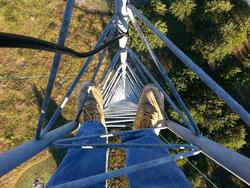
.jpg)
